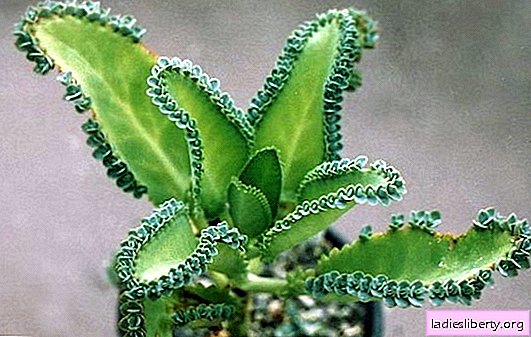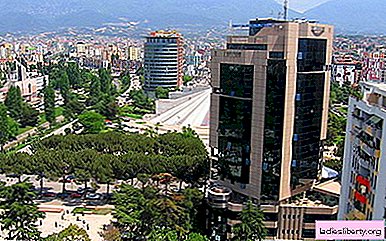
Kalanchoe (meaning "thick" and refers to succulent Crassulaceae) is an amazing flower that you will want to grow not only for amazingly blooming flowers, but also for the healing properties of the leaves.
In people, this species is also called a "living doctor."
The properties of Kalanchoe are similar to the properties of drugs.
It has an anti-inflammatory effect. It has a wound healing, disinfecting and antimicrobial effect.
Concentrated juice can be used as a laxative.
For children, drops of Kalanchoe leaflets are instilled in the nose with a runny nose.
The crumpled leaflet helps relieve toothache.

Treatment of the common cold Kalanchoe
Kalanchoe: home care - breeding
What all the lovers of this plant will agree on is that Kalanchoe is very unpretentious when leaving at home. And the conditions for its reproduction are very simple.
There are several ways to do this:
1) Cuttings - You can root both a piece of the stem and the leaf. Escape must be chosen strong and even up to 10 cm long with beautiful leaves. It must be planted in such a way that the lower leaves lie on the surface. If necessary, then shorten the part of the stem to the desired size.
Tip: nip seedlings regularly (remove tops). This will arouse the growth of side buds and cause lush flowering of the bush.
As for rooting by a leaf, in this case it is necessary to pinch off the leaf from the mother plant (best in early summer) and plant it in the ground. You can cover with a jar and spray from time to time. Soon, the leaf will start up.

Propagation by cuttings
2) Kids. This method is not suitable for all types. There are some in which kidneys form on the boundary surface of the leaf with an already formed rosette of leaves and roots. Having reached the maximum plant, they fall and take root in the soil. They can also be immediately planted in the ground.
3) Similarly to the above method, and reproduction by axillary buds. It also does not apply to all types of plants. The bottom line is that after flowering, new buds hatch in place of old leaves and subsequently fall under their own weight. Having fallen to the ground, they quickly take root. When caring for Kalanchoe at home, it is not necessary to wait until such shoots fall off. They can be cut and planted in prepared soil with a high sand content. After a week, you can notice the formation of roots.
4) Seeds - The reproduction process is rather favorable in this case too. It is best to sow in late February - early March. To do this, sow seeds on the surface, press them with your finger, without sprinkling with soil on top. The container is covered with glass or polyethylene, ventilating in the morning and evening.
Watch at this time for the temperature, which should be between + 16 - +20 degrees. At first, it is necessary to carry out regular watering and to prevent drying of the soil. When the first sprouts appear, the shelter is removed. After a month, the sprouts can be dived into a larger container. Kalanchoe is transplanted to a permanent place when 3-4 leaves appeared on her stalk. To do this, pour drainage on the bottom of the pot, which is slightly larger in diameter, and mix the prepared soil from above. When the flower is rooted, the top must be clipped for better branching. To observe the magnificence of the flowering of this plant can be observed as early as next year.
An adult plant must be transplanted once every two years. But for some species this can be done more often - once a year. A sign indicating the need for transplantation is excessive filling of the pot with roots. Note also that this flower does not like large containers.
Kalanchoe: home care - soil, lighting, flowering conditions
The soil: to plant stems, leaves, children is necessary in the soil with a high content of peat (4), as well as turf land (2) and sand (1). Some amateur gardeners note that the use of coniferous land as a substitute for peat will also favorably affect the development of the plant. For older plants, the soil will be compost, humus, deciduous soil and sand (4: 2: 1: 1).
Also, the soil should be neutral or slightly acidic. It is best and most convenient to use the usual succulent mixture. Be sure to provide good drainage at the bottom of the pot.
Lighting: the middle ground rule applies here. For Kalanchoe, the optimal daylight hours are 12 hours. Adequate lighting is necessary for him. That is, if you put the pot on the server window, then the light will obviously not be enough, and the plant will stretch, weaken, the leaves will fall and it will not bloom. If you choose the southern window, the flower may get burns. It is better to put Kalanchoe in this place in winter. Window sills on the east or west side are ideal from spring to autumn. Also, you should always remember that you can adjust the brightness of the lighting with the help of curtains that protect plants from the midday sun. And with a short daylight, which usually happens in winter, additional artificial lighting will help.
Temperature: Kalanchoe is relatively calm at any temperature. Reasonably, of course. The plant will feel comfortable in the summer at a temperature of no higher than 30 ° C, and in winter at least 10 ° C. This flower is not afraid of temperature differences, unlike many flowering plants. In the summer, arrange your small flowered balcony in the fresh air, where the presence of Kalanchoe will be a wonderful decoration.
Circumcision: very important for flowering species, as it allows you to maintain the attractiveness of the flower. The inflorescence with flowers on the stalks, after they have bloomed, is cut as low as possible. All wilted and weakened parts of the plant must be removed. They will only take power and energy from the plant.
Also, shoots of Kalanchoe can be cut and planted separately or in the same pot. In some species, the shoots cross over the edge of the pot - they can also be cut off and planted nearby, or you can leave them hanging.
Also, it is desirable to rejuvenate the plant by clinging to the top of the flower so that lateral shoots are formed. So, the plant will acquire a beautiful decorative look, and will not stretch and grow.
Conditions for flowering:
1) bright lighting (not direct sunlight) no more than 10-12 hours;
2) the use of complex fertilizers. However, caution is needed in this case. Since excess or lack of nutrition can lead to the opposite effect;
3) timely remove faded flowers, this will ensure the emergence of new ovaries.

Types of Kalanchoe
Some types of flowers can be cut and placed in a vase. They will delight you with their beauty for a long time anywhere in the house or on your desktop. Do not be sad if your flower, after flowering, has lost its attractive appearance. Cut it, and it will again delight you with a gorgeous flowering. You can use the cut shoots for cuttings.
Important: after flowering, the plant has a dormant period. At this time, it must be moved to a place with dim light, significantly reduce watering and stop feeding. After about a month, you can return it to its place.
Kalanchoe: home care - top dressing and watering
Watering: use warm water. Take care not to flood the plant. This can lead to rotting of the roots. But at the same time, droughts should also not be allowed, as this will lead to leaf fall. As you can see, adverse effects will be observed in one and the other case. When overflowing, the plant will decay, and if watering is insufficient, it will dry out. Thus, regularity depends on the natural drying of the topsoil.
If you need to leave for a few days, then this flower will painlessly endure this parting. In winter, watering is reduced and watered even a few days after the drying of the soil. Also, almost no watering is carried out during the dormant period of the plant, which occurs after flowering.
Experienced flower growers successfully use the method - watering through a pallet.
Humidity: Kalanchoe does not require spraying, but in hot weather it will only positively affect the development of the plant. This is due to the fact that in Kalanchoe, the leaves are fleshy and moisture evaporates weakly, i.e. moisture accumulates in the leaves. If necessary, wipe the leaves with a damp cloth.
Top dressing: Kalanchoe requires fertilizer only in the summer or when setting buds in the fall. You can use fertilizers that are designed for cacti or complex. Do not overfeed your plant, otherwise it may not bloom.
Kalanchoe: home care: why does it die?
With improper care at home, bloom can appear on the Kalanchoe, as well as brown or black spots, if the plant is excessively watered at low air temperature.
High air temperature and heavy watering can lead to a disease such as powdery mildew.
At high temperatures, the leaves may dry and die, and the flowers may not bloom.
In some species, the stems can stretch and expose - do not worry, this process is natural.
Also, during flowering or in spring, Kaklancho can observe such an unpleasant process as falling of the lower leaves. This suggests the need for additional plant nutrition.
If your plant is in one place on the windowsill and you suddenly notice the appearance of dry brown spots that lead to leaf falling, then this indicates the presence of burns. They can be like sunny, or they can be from the fact that the plant has little space and it needs to be rearranged on a special stand.
Kalanchoe also has such a dangerous pest as a spider mite. It eats plant juice and multiplies very quickly. To combat it, it is necessary to wash the entire plant with a warm solution of laundry soap. Effective decoction of cyclamen tuber. You can also try using insecticides.
No less dangerous is the scale shield, with which it is also necessary to carry out the necessary measures in time. The scab is removed with a brush or wet washcloth, which is moistened with soapy water. Also in this case, you can use an alcohol solution, but you must do this carefully.
Also, one of the reasons for the death of a plant may be improper care for it immediately after acquisition. You must bear in mind that when the location and conditions of detention change, the plant in any case experiences stress. But to subject it to another stress - a transplant is necessary.
Observe the following rules during this process:
1) do not use the peat in which the plant was kept for sale;
2) use a slightly larger pot;
3) be sure to lay the drainage to the bottom;
4) do not rinse the roots, but simply shake off excess peat;
5) carry out the necessary watering;
6) put the flower in a permanent place, in accordance with the conditions necessary for it, and leave the plant alone
Watch your plant carefully and the unpretentious, viable flower of Kalanchoe itself will tell you that when leaving at home, he does not like it.











